Related Research Articles

In classical antiquity and Greco-Roman geography, Colchis was an exonym for the Georgian polity of Egrisi located on the eastern coast of the Black Sea, centered in present-day western Georgia.

Arrian of Nicomedia was a Greek historian, public servant, military commander, and philosopher of the Roman period.

Abkhaz, also known as Abkhazian, is a Northwest Caucasian language most closely related to Abaza. It is spoken mostly by the Abkhaz people. It is one of the official languages of Abkhazia, where around 100,000 people speak it. Furthermore, it is spoken by thousands of members of the Abkhazian diaspora in Turkey, Georgia's autonomous republic of Adjara, Syria, Jordan, and several Western countries. 27 October is the day of the Abkhazian language in Georgia.

The Principality of Abkhazia emerged as a separate feudal entity in the 15th-16th centuries, amid the civil wars in the Kingdom of Georgia that concluded with the dissolution of the unified Georgian monarchy. The principality retained a degree of autonomy under Ottoman and then Russian rule, but was eventually absorbed into the Russian Empire in 1864.

The Abkhazia conflict is a territorial dispute over Abkhazia, a region on the eastern coast of the Black Sea in the South Caucasus, at the intersection of Eastern Europe and Western Asia. The conflict involves Georgia, Russian Federation and Russian-backed self-proclaimed Republic of Abkhazia, internationally recognised only by Russia, Venezuela, Nicaragua, Nauru, and Syria; Georgia and all other United Nations members consider Abkhazia a sovereign territory of Georgia. However, as of 2023, Georgia lacks de facto control over the territory.

The Abkhazians or Abkhazes are a Northwest Caucasian ethnic group, mainly living in Abkhazia, a disputed region on the northeastern coast of the Black Sea. A large Abkhaz diaspora population resides in Turkey, the origins of which lie in the Caucasian War in the late 19th century. Many Abkhaz also live in other parts of the former Soviet Union, particularly in Russia and Ukraine.

The Kingdom of Abkhazia, also known Egrisi-Abkhazia, was a medieval feudal state in the Caucasus which was established in the 780s. Through dynastic succession, it was united in 1008 with the Kingdom of the Iberians, forming the Kingdom of Georgia.
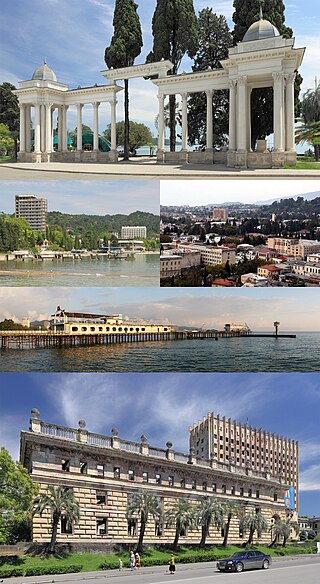
Sukhumi is a city in a wide bay on the Black Sea's eastern coast. It is both the capital and largest city of the Republic of Abkhazia, a partially recognised state that the international community considers a part of Georgia. The city has been controlled by Abkhazia since the Abkhazian war in 1992–93. The city, which has an airport, is a port, major rail junction and a holiday resort because of its beaches, sanatoriums, mineral-water spas and semitropical climate. It is also a member of the International Black Sea Club.

The Bzyb or Bzipi is one of the two largest rivers of Abkhazia and the twelfth longest river in Georgia. The river valley has rich biodiversity of herbaceous garden plants, particularly in the gorge section in the upper reaches where the most prominent and colourful bellflower Campanula mirabilis with profuse growth of 100 flowers per plant is given the name, the "Queen of the Abkhazian flora". During 1904-1917 it served as the border between the Russian Empire's Sukhumi Okrug and the Black Sea Governorate.

Ochamchire or Ochamchira is a seaside city on the Black Sea coast of Abkhazia, Georgia, and a centre of an eponymous district.

Abzhywa is one of the seven historical regions in Abkhazia, and accordingly one of the seven stars on Flag of Abkhazia represents Abzhywa. Local residents belong to ethnographic group of Абжуйцы.

The history of Abkhazia, a region in the South Caucasus, spans more than 5,000 years from its settlement by the lower-paleolithic hunter-gatherers to its present status as a partially recognized state.
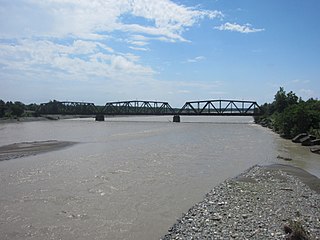
The Kodori is one of the two largest rivers of Abkhazia, along with the Bzyb. It is formed by the joining of the rivers Sakeni and Gvandra. The Kodori is first among Abkhazia's rivers with respect to average annual discharge at 144 cubic metres per second (5,100 cu ft/s) and drainage basin area at 2,051 square kilometres (792 sq mi). It is second after the Bzyb with respect to length at 105 kilometres (65 mi) when combined with the Sakeni.

The Socialist Soviet Republic of Abkhazia was a short-lived republic within the Caucasus region of the Soviet Union that covered the territory of Abkhazia, and existed from 31 March 1921 to 19 February 1931. Formed in the aftermath of the Red Army invasion of Georgia in 1921, it was independent until 16 December 1921 when it agreed to a treaty that united it with the Georgian Soviet Socialist Republic. The SSR Abkhazia was similar to an autonomous Soviet republic, though it retained nominal independence from Georgia and was given certain features only full union republics had, like its own military units. Through its status as a "treaty republic" with Georgia, Abkhazia joined the Transcaucasian Soviet Federative Socialist Republic, which united Armenian, Azerbaijani, and Georgian SSRs into one federal unit when the latter was formed in 1922. The SSR Abkhazia was abolished in 1931 and replaced with the Abkhaz Autonomous Soviet Socialist Republic within the Georgian SSR.
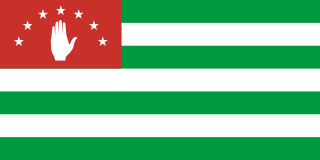
Abkhazia, officially the Republic of Abkhazia, is a partially recognised state in the South Caucasus, on the eastern coast of the Black Sea, at the intersection of Eastern Europe and Western Asia. It covers 8,665 square kilometres (3,346 sq mi) and has a population of around 245,000. Its capital and largest city is Sukhumi.
Tsebelda culture is a late antiquity to early medieval archaeological culture in the territory of the Apsilae or Tsebelda tribe, located in Abkhazia, Georgia on the Black Sea coast. The culture is known mainly from excavation of burial sites, starting in 1959, which yielded a large collection of artefacts.

The Abasgoi or Abasgians were one of the ancient tribes inhabiting western region of Abkhazia, who originally inhabited lands north of Apsilae, corresponding to today's Ochamchira District. In 550, during the Lazic War, the Abasgians revolted against the Eastern Roman (Byzantine) Empire and called upon Sasanian assistance. General Bessas however suppressed the Abasgian revolt.
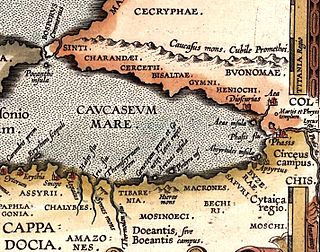
The Heniochi were an ancient tribe inhabiting northwest shores of Colchis and some say Phasis area. Their country was called Heniocheia.
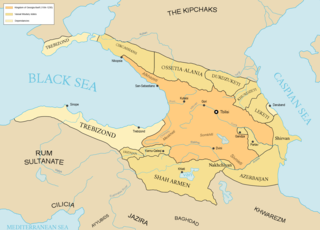
Nicopsis, Nikopsis, or Nikopsia was a medieval fortress and town on the northeastern Black Sea coast, somewhere between the Russian towns of Tuapse and Gelendzhik. It features in the medieval Greek and Georgian sources as a Byzantine outpost and then as the northwestern extreme of the Kingdom of Georgia. A center of Christianity in the region known as Zichia, Nikopsis was at times a Byzantine bishopric and was believed to be a burial place of the apostle Simon the Canaanite.

The Sukhumi or Sukhum okrug was a special administrative district (okrug) in the Caucasus Viceroyalty of the Russian Empire, part of the Kutaisi Governorate from 1883 until 1905. The administrative center of the district was the Black Sea port city of Sukhum. The okrug bordered the Kutaisi Governorate to the southwest, the Kuban Oblast to the north and the Black Sea Governorate to the northwest and in terms of its area corresponded to most of contemporary Abkhazia. During 1905–1917, the Sukhumi okrug was one of the smallest independent administrative units of the Russian Empire, second to the Zakatal okrug.
References
- 1 2 "Апсилы". Bse.sci-lib.com. Retrieved 2013-10-21.
- 1 2 Alexander Mikaberidze (6 February 2015). Historical Dictionary of Georgia. Rowman & Littlefield Publishers. pp. 130–1. ISBN 978-1-4422-4146-6.
- ↑ "Apsilae". Brill. Retrieved 12 March 2024.
- ↑ George Hewitt, "The Abkhazians: Handbook", p. 56
- ↑ Greek geography (1854). Dictionary of Greek and Roman Geography: Abacaenum-Hytanis. Walton & Maberly. p. 163.
- ↑ Arrian; Thomas Falconer (1805). Arrian's Voyage Round the Euxine Sea: Translated and Accompanied with a Geographical Dissertation and Maps : to which are Added Three Discourses, I. On the Trade to the East Indies by Means of the Euxine Sea, II. On the Distance which the Ships of Antiquity Usually Sailed in Twenty-four Hours, III. On the Measure of the Olympic Stadium. J. Cooke. p. 9.
- ↑ Julian Bennett (2 September 2003). Trajan: Optimus Princeps. Routledge. p. 345. ISBN 1-134-70913-7.
